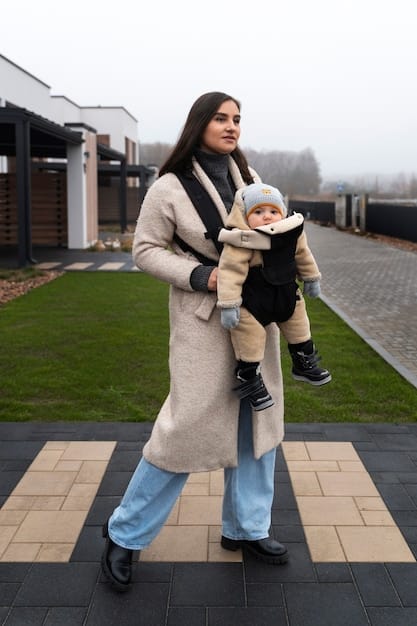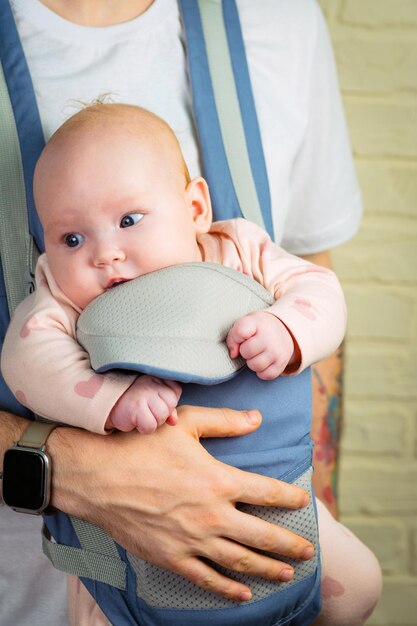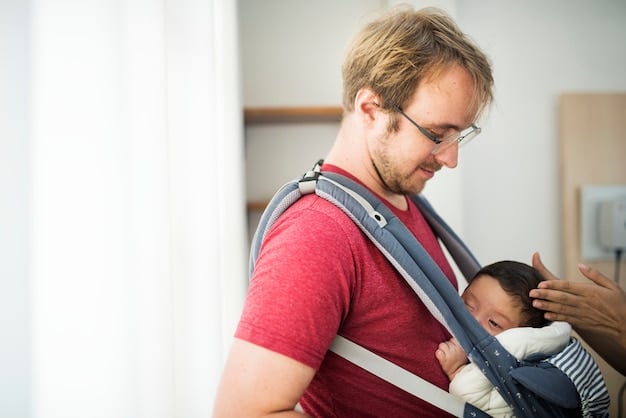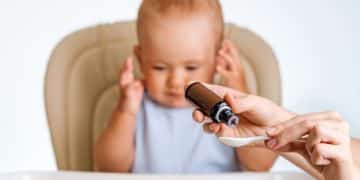Babywearing Safety 2025: New Guidelines for US Parents

Babywearing safety in 2025 is paramount for US parents and caregivers. New guidelines emphasize proper carrier fit, airway monitoring, and awareness of environmental hazards to ensure the well-being of infants while enjoying the benefits of babywearing.
Babywearing safety: New Guidelines Every US Parent Should Know in 2025 ensures a secure & happy bonding experience. By staying informed & following best practices, you can confidently keep your little one close while navigating daily life.
Understanding the Evolution of Babywearing Safety Standards
Babywearing has evolved from simple slings to sophisticated carriers, and with it, safety standards have become more rigorous. Understanding this evolution is key to ensuring your baby’s well-being.
Staying up-to-date with the latest safety guidelines helps parents make informed decisions about the types of carriers they use and how to use them correctly. Here’s what you should know about the evolution.
Historical Context of Babywearing
Historically, babywearing was more about practicality than comfort or safety. Traditional methods often lacked the ergonomic design and safety features we expect today.
Modern Safety Innovations
Modern carriers incorporate advanced materials, improved designs, and rigorous testing to meet stringent safety standards. These innovations aim to minimize risks and enhance comfort for both parent and child.
- Ergonomic Design: Ensures proper hip and spine development for the baby.
- Secure Fastenings: Prevents accidental slips or falls.
- Breathable Materials: Reduces the risk of overheating.
The evolution of babywearing safety reflects a growing understanding of infant physiology and biomechanics, leading to safer and more user-friendly products. Embracing these advancements allows parents to enjoy the benefits of babywearing with greater confidence.
Key Safety Guidelines for Babywearing in 2025
As we move into 2025, several key safety guidelines are paramount for parents who choose to wear their babies. These guidelines focus on proper techniques, carrier selection, and awareness of potential hazards.
These guidelines are designed to minimize risks and ensure a safe and enjoyable babywearing experience. Let’s explore the essential safety precautions.

TICKS Rule for Safe Babywearing
The “TICKS” rule is a handy mnemonic for remembering the most important aspects of safe babywearing. Each letter represents a crucial safety check.
Choosing the Right Carrier
Selecting a carrier that is appropriate for your baby’s age, weight, and developmental stage is essential. Different carriers offer varying levels of support and adjustability.
- Tight: The carrier should be snug against both you and your baby.
- In view at all times: You should always be able to see your baby’s face by simply glancing down.
- Close enough to kiss: Your baby’s head should be close enough to kiss.
Staying updated on the latest recommendations and guidelines ensures that you are using your baby carrier in the safest way possible. Prioritizing safety allows you and your baby to enjoy all the benefits of babywearing with peace of mind.
Choosing the Right Carrier for Your Baby’s Age and Development
Selecting the appropriate carrier for your baby’s age and developmental stage is critical. Different carriers offer varying levels of support and adjustability, which is crucial for ensuring your baby’s comfort and safety.
Understanding the nuances of each carrier type, along with your baby’s specific needs, will help you make the best choice. Here’s what to consider.
Newborn-Friendly Carriers
For newborns, soft wraps and ring slings are often recommended. These carriers provide gentle support and allow you to keep your baby close, mimicking the womb environment.
Carriers for Older Babies and Toddlers
As your baby grows, structured carriers and hip seats may become more suitable. These options offer better weight distribution and support for heavier babies and toddlers.
- Soft Wraps: Ideal for newborns, providing a snug and secure fit.
- Ring Slings: Adjustable and easy to use, suitable for quick carries.
- Structured Carriers: Offer excellent support and are great for longer periods of babywearing.
Always check the manufacturer’s guidelines for weight and age recommendations to ensure you are using the carrier safely and effectively. The right carrier will adapt to your baby’s changing needs, providing comfort and security at every stage.
Recognizing and Avoiding Common Babywearing Hazards
Despite the numerous benefits of babywearing, it’s important to be aware of potential hazards and take steps to avoid them. Recognizing these risks can help you create a safer environment for your baby.
Understanding these potential dangers and how to mitigate them is essential for a safe babywearing experience. Here’s what you need to know.
Suffocation Risks
One of the most significant hazards is suffocation. Ensure your baby’s face is always visible and clear of any fabric or obstructions.
Overheating and Sweat Management
Babies can easily overheat in carriers, especially in warm weather. Dress your baby in light, breathable clothing and monitor them for signs of overheating.
- Proper Positioning: Always ensure your baby’s face is visible and not pressed against your body.
- Monitoring Temperature: Check your baby regularly for signs of overheating, such as sweating or flushed skin.
- Awareness of Surroundings: Be mindful of potential hazards like hot stoves or sharp objects.
By staying vigilant and aware of these common hazards, you can significantly reduce the risks associated with babywearing and ensure your baby’s safety. Taking proactive steps will allow you to enjoy the closeness and convenience of babywearing with confidence.

The Role of Education and Resources in Promoting Safe Babywearing
Education and access to reliable resources play a crucial role in promoting safe babywearing practices. Knowledge is power, and informed parents are more likely to make safe choices.
By leveraging educational resources and seeking guidance from experienced professionals, parents can minimize risks and maximize the benefits of babywearing. Here’s how education can help.
Importance of Proper Fitting
A properly fitted carrier is essential for both comfort and safety. Seek guidance from certified babywearing educators to ensure your carrier fits correctly.
Utilizing Online Resources and Workshops
Numerous online resources, workshops, and support groups offer valuable information and hands-on training in safe babywearing techniques.
- Certified Babywearing Educators: Provide personalized guidance and fitting assistance.
- Online Tutorials: Offer step-by-step instructions and safety tips.
- Support Groups: Connect you with other parents who can share their experiences and advice.
Investing in education and utilizing available resources demonstrates a commitment to ensuring your baby’s safety and well-being. By staying informed and seeking expert guidance, you can confidently navigate the world of babywearing and enjoy all its benefits.
Future Trends and Innovations in Babywearing Technology
As technology advances, we can expect to see further innovations in babywearing design and safety features. These trends aim to enhance comfort, convenience, and overall safety for both parents and babies.
Staying abreast of these emerging trends can help you make informed decisions about future babywearing products. Let’s take a look at what the future holds.
Smart Carrier Technology
The integration of smart technology into baby carriers could provide real-time monitoring of baby’s vital signs, temperature, and positioning.
Sustainable and Eco-Friendly Materials
A growing emphasis on sustainability will likely lead to the development of carriers made from eco-friendly and ethically sourced materials.
- Improved Ergonomics: Enhanced designs to promote better posture and weight distribution.
- Advanced Safety Features: Smart sensors and alerts for potential hazards.
- Customizable Options: Carriers that can be tailored to individual needs and preferences.
Embracing these innovations will not only improve the babywearing experience but also contribute to a safer and more sustainable future. By staying informed and open to new developments, you can make the most of the evolving landscape of babywearing technology.
| Key Element | Brief Description |
|---|---|
| 👶 Proper Positioning | Ensure baby’s face is always visible and airway is clear. |
| 🌡️ Temperature Control | Dress baby in breathable clothing to avoid overheating. |
| ✅ Carrier Fit | Adjust carrier for snug fit, supporting baby’s hips & spine. |
| 📚 Education | Seek guidance from educators for safe practices. |
Frequently Asked Questions About Babywearing Safety
▼
TICKS stands for Tight, In view at all times, Close enough to kiss, Keeps chin off chest, and Supported back. This ensures the baby is safe and properly positioned in the carrier.
▼
Dress your baby in light, breathable clothing, avoid direct sunlight, and monitor for signs of overheating such as sweating, flushed skin, or rapid breathing. Ensure good ventilation.
▼
Soft wraps and ring slings are often recommended for newborns as they provide gentle support and allow you to keep your baby close, mimicking the womb environment. Ensure proper head and neck support.
▼
Check on your baby frequently, at least every 15-30 minutes, to ensure their airway is clear, they are comfortable, and they are not showing signs of distress or overheating.
▼
Seek assistance from certified babywearing educators, local baby stores that offer fitting services, or online tutorials and support groups for guidance on properly fitting your carrier.
Conclusion
Staying informed about babywearing safety: New Guidelines Every US Parent Should Know in 2025 allows you to protect your baby and enjoy this amazing bonding experience worry-free. Prioritize education, choose the right carrier, and always be aware of potential hazards.





